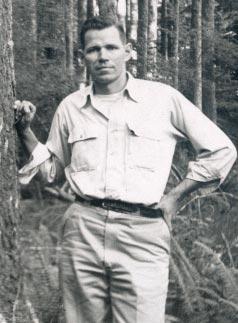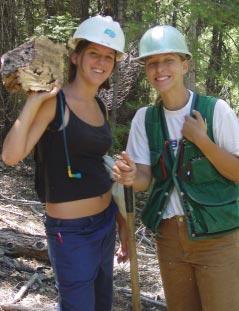
5 minute read
Highlights of Excellence
FOR MORE THAN 130 YEARS, RESEARC HERS ATTHE COLLEGE
have made major contributions to science and society. The accomplishments of the College are too numerous for us to comprehensively address in this special issue. The following sections highlight just a few areas in which the College has both a strong history and exciting future:forestry,rangeland science,agricultural economics,social science, entomology and pest management,nutrition and toxicology,plant and microbial biology,and soil science. Throughout the College's history,common values persist:adaptation to social change,development and adoption of new technology, and advancement of an interdisciplinary world view.
Advertisement
An Integrated Approach to Forestry
Although a forestryprogram was first proposed at Berkeleyin 1886 and again in 1899, it did not get off the ground easily. The Universityof Southern California opened a forestryschool in 1889 but it closed within one year. Proposals failed to pass the state assemblyin both 1903 and 1905. But researchers with the College of Agriculture were still active in forestry.
It took enthusiastic student interest and advocacy, as well as facultysupport, to establish a formal home for the studyof both the basic aspects of forest biologyand the practical aspects of timber harvesting. The student forestryclub began in 1911 and in 1914, the College of Agriculture launched a Division of Forestry.
The first head of the forestryprogram, Walter Mulford, set forth a lasting vision for forestry, just as Hilgard had done for the College. He developed a strong undergraduate program based for the first two years on general academic enrichment, followed byspecialization in either forest management or logging engineering in the upper division courses. He established forestrysummer camp, an intensive field course that continues to this dayas one of the strongest communitybuilding educational experiences on the Berkeleycampus. And he founded an outstanding forestrylibrarybydonating his own collection of books.
In 1922, the forestryprogram also launched a program in grassland ecologyand management, housed todayin the Division of Ecosystem Sciences (see Rangeland Science).
In 1926, WoodyMetcalf was appointed as the first Cooperative Extension forester. He played a keyrole in developing better rural fire protection throughout the state. In 1934, Frederick Baker, a professor of silviculture at Berkeley, produced Theoryand Practice of Silviculture, the first American textbook in its field.
Other major forestryresearch took place during these years. Joseph Kittredge Jr., who came to Berkeleyin 1932 as professor of forestryand an ecologist in the Agricultural Experiment Station, pioneered studies on the effect of forest vegetation on water storage and snowmelt. Harold Biswell, who joined the facultyin 1947, conducted the first experiments using prescribed burning to reduce the risk and severityof wildfire in California.
ìBiswell was the first to challenge the orthodoxybyasking if we were doing the right thing by eliminating all fire. That was a reallyradical idea at the time,îsaid Professor Emeritus Dennis Teeguarden, former chair of the Department of Forestryand Resource Management.
The field of forest photogrammetryalso owes much to Berkeleyresearch. Bob Colwell, a Berkeleyplant physiologygraduate, joined the facultyin 1947. He was one of the first experts in the young field and was a catalyst for the development of remote-sensing techniques. He went on to playan instrumental role in the launch of LANDSAT 1, which revolutionized the fields of cartography, forestry, geology, and land use.
Just before Mulfordís 1946 retirement, the division was separated from the College of Agriculture into a professional school as part of the establishment of the UC systemwide Division of Agricultural Sciences. As a professional school, the School of Forestrycould offer onlyupper division and graduate programs. The lower division pre-forestryprogram remained with the College of Agriculture.
HenryJ. Vaux became dean of the School of Forestryin 1955. By1964, the School was rated among the top three or four programs in the U.S. A balanced approach between teaching and research and more visibilityfor the Agricultural Experiment Station marked his tenure. But Vauxís greatest influence came later. He served as chairman of the State Board of Forestryfrom 1976 to 1983 and guided major revisions of the forest practice rules, which were based, in part, on research at Berkeley. ì When I came to Berkeley, forestrywas almost exclusivelyoccupied with the timber resources, as it was in most forestryschools around the country,îsaid Teeguarden. ìLegislation such as the Endangered Species Act and National Forest Management Act sent a clear message from society that forests are valuable on a broader basis than trees alone.îIntegrated management for a whole bundle of values became the goal.
Professor John A. Zivnuska followed Vaux as the fourth dean of the School of Forestry(19651974). Zivnuska and Vaux were pioneers in establishing the field of forest economics as a subdiscipline of land and resource economics. Zivnuska was internationallyknown for his works in forest resource evaluation, industrial economics, forest taxation, long-term demand and supplyanalysis, and international forestry.
In 1967, the necessityof incorporating other academic disciplines into the studyof forestryled to the transfer of the campus wildlife and fisheries program to the School of Forestry, led by Professor Starker Leopold. Through his public service on several advisoryboards for the Department of Interior, Leopold set the framework for resource management policyin the National Park Service, and the national wildlife refuge system.
In addition to his scientific and policyaccomplishments, Leopold was known as one who could bridge gaps between diverse groups with opposing viewpoints over natural resource use. Leopold and his students made wildlife a strong and ongoing part of the research and curriculum. In 1968, the Schoolís name was changed to reflect this expansion, to the School of Forestryand Conservation.

Bythe 1970s, the Berkeleyprogram ranked as the nationís number-one forestryschool. Nearly all of the top positions in public forestrywere held byalumni, as were leadership positions in industryand academia.
Berkeleyís forestryprogram also made great strides in attracting females to a male-dominated field. It is believed that the first B.S. in forestryawarded to a woman was to Alice Craig from Berkeley(í28). But still, by1965, onlynine women had graduated from the Berkeleyprogram and onlythree had attended summer camp. However, growing interest in the environment in the 1970s led to more women considering forestryas a potential career. Last year, 60 percent of the forestry program graduates were female.

In 1984, Louise Fortmann, a rural sociologist, was recruited as the first female facultyin forestry at Berkeley. ìA lot of the ëfirst womeníappointed to academic units are unwelcome and their lives are made miserable. Here theytried to do everything theycould to help me,îsaid Fortmann. Professor Fortmann nowchairs the Division of Societyand Environment (see page 13).
Crucial to the forestryprogramís research and teaching have been forested properties acquired in the early1900s. In 1933, Mulford recommended that the Regents accept a donation of 2,680 acres of mixed conifer land in El Dorado County. Named Blodgett Forest in honor of the principal owner of Michigan-California Lumber Company, who donated the land, the site has for manyyears been one of the primaryresearch and demonstration forests on the Pacific Coast. Purchases and additional donations have increased Blodgett Forest Research Station to its current 4,400 acres. Today College facultyuse the station for more than 80 research projects on fire, global climate change, silviculture, wildlife, and other aspects of forestryand forest ecology. Other College forestry properties include Howard Forest in Mendocino County, Whitaker Forest in Tulare County, Baker Forest (including summer camp) in the Plumas National Forest, and the Russell Reservation in Contra Costa County.




